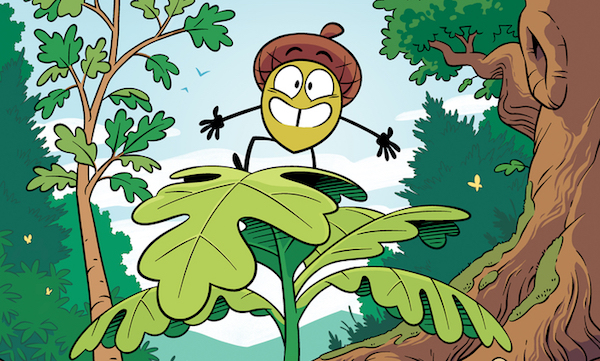
Review: ‘Trees: Kings of the Forest’
Science Comics: Trees: Kings of the Forest
Writer/artist: Andy Hirsch
First Second; $12.99
Ask any group of little kids what they want to be when they grow up, and chances are none of them will answer that they want to be a tree. Not only would it be impossible for a human child to grow up to be a tree—not that the viability of a life goal is always a consideration very young children take into account—but even if it were possible, it doesn’t seem all that exciting. In fact, even some children who are supposed to grow up to be trees don’t want to. For example, take Acorn, the acorn protagonist of First Second’s new Science Comics offering, Trees: Kings of The Forest.
 “They just sit there,” Acorn tells a concerned frog who tries to stop the little one from wandering off. “I don’t wanna grow up to be a big leafy…statue! I wanna do things, I wanna meet friends, I wanna make a difference—I wanna live!” The fact that Acorn needs to be convinced of how amazing trees are before committing to being one is the hook on which Andy Hirsch’s edutainment comic hangs.
“They just sit there,” Acorn tells a concerned frog who tries to stop the little one from wandering off. “I don’t wanna grow up to be a big leafy…statue! I wanna do things, I wanna meet friends, I wanna make a difference—I wanna live!” The fact that Acorn needs to be convinced of how amazing trees are before committing to being one is the hook on which Andy Hirsch’s edutainment comic hangs.
ADVERTISEMENT
ADVERTISEMENT
The frog, and a series of other forest dwellers—an anthropomorphic fern, a beetle, a squirrel, a woodpecker, and a mushroom—spend the book educating Acorn on what exactly trees are, what distinguishes them from other plants, and what impact they have on the world. By the end of the book it becomes apparent that being a tree will meet all of the goals that Acorn articulated while attempting to walk away from destiny at the beginning…and that all these volunteer teachers have a vested interest in Acorn becoming a tree, as each of them benefit from the presence of trees. (Spoiler alert: Acorn does indeed decide to stay and be their tree, tipping his cap to them and then pirouetting into the ground to plant himself.)
If you’ve read any of the previous Science Comics comic books, then you have a pretty solid idea of the format for this one. The story, such as it is, really only serves as a framework for a kids’ textbook worth of information and an excuse to put all that information into a comics format. Without the little drama regarding Acorn and his reservations about being a tree, we wouldn’t have a reason for cartoon characters to talk in great detail about trees, or for anyone to ask follow-up questions. Rather, the book would just have a lot of narration couched in panels. (Additionally, the characters allow for the occasional gag to slip into all of the tree facts; there is even a perhaps inadvertent running gag in the fact that all these random characters know so much about trees that they sound like botany professors but, well, why wouldn’t a squirrel or a wood-eating beetle have a savant’s expertise on a subject so important to them?)
Yes, it leans quite heavily in the direction of non-fiction, but it looks great, it reads like a comic—if a somewhat slow-moving, word-heavy one—and the great thing about comics is, of course, that they can convey a page or so worth of information in an extremely readable format. Think of Science Comics as a textbook that is all charts, figures, and illustrations, and those charts, figures, and illustrations tell a little dramedy while also telling us seeds grow, how trees reproduce, their specific niche in the environment, and on and on. The amount of information in here is both broad and deep, and pretty remarkably up to date, covering recent-ish research into how trees communicate via the mycorrhizal network created by fungus, which a researcher jokingly refer to as “the wood wide web.”
The thing that differentiates First Second’s Science Comics from one another, aside from the subject matter, of course, is the style of the art. Hirsch’s is incredibly open, bright and inviting, with a simplified amount of detail that doesn’t stray so far into abstraction that what is being covered becomes hard to recognize. The animal characters are perhaps nothing special, but his plant characters like the mushroom, the fern, and, especially, Acorn are all knockouts.
Treating the entire acorn as a head wearing a little hat-like cap, and then adding stick figure-like limbs to it, Hirsch has designed a character that is pretty much all face, a perfect one for broadcasting emotions through always exaggerated, but sometimes somewhat subtle, expressions. It’s a great design, and Hirsch is an accomplished “actor” acting through Acorn.
There aren’t really any bad comics in this line of books, but Trees? It’s a particularly good one.
About J. Caleb Mozzocco
J. Caleb Mozzocco is a way-too-busy freelance writer who has written about comics for online and print venues for a rather long time now. He currently contributes to Comic Book Resources' Robot 6 blog and ComicsAlliance, and maintains his own daily-ish blog at EveryDayIsLikeWednesday.blogspot.com. He lives in northeast Ohio, where he works as a circulation clerk at a public library by day.
ADVERTISEMENT
ADVERTISEMENT
SLJ Blog Network
2024 Books from Pura Belpré Winners
Passover Postings! Chris Baron, Joshua S. Levy, and Naomi Milliner Discuss On All Other Nights
Parsing Religion in Public Schools
Crafting the Audacity, One Work at a Time, a guest post by author Brittany N. Williams
ADVERTISEMENT








